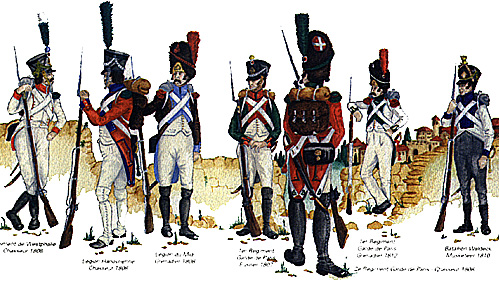Left to right in illustration:
1. Regiment de Westphalie: Chasseur 1808 After Regondaud and Blondisau. Rigo's plate shows a sergeant NCO's were distinguished by yel/ow coloured shako cords worked through with green. They had a broad yellow band round the top of the shako and broad yellow piping to the shoulder straps and yellow crescents to the epaulettes. Badges of rank followed French precedence being gold coloured piped in red.
2. Legion Hanovrienne: Chasseur 180B. Affer Rigondaud Rigo's il/ustration depicts a chasseur sergeant-major and junior officer. Chasseur NCO's were distinguished by a single broad white band round the top of the shako. They have silver coloured epaulettes with a green edge to the fringe, silver coloured crescents and two silver coloured bands either side of the green shoulder straps. Rank badges were saver coloured piped in blue.
3. Legion du Midi: Grenadier 1808. After Boisselier Boisselier's card in the Bucquoy series shows white gaiters. The plate to the bonnet a poll bears an embossed eagle.
4. Garde de Paris: Fusilier 1er Regiment 1807. After Girbal and Margerand Girbal shows the white piping throughout his illustrations in Dr Hourtoulle's series of plates. Margerand's naive rendition of a fusilier in the Bucquoy series of cards is based on Martinet. It also seems to show white piping, except on the collars which are piped in red and green for first and second regiments respectively. This appears to be the best of all possible worlds. This apparent dichotomy where piping is concemed remains unreconciled by the ex,oerts, and seems to depend upon the original source used by the artist in question. My sketch follows the 'Otto' artist's rendition of grenadier and chasseur uniforms in the context of piping, which is essentially a simple reversal of respective regimental schemes. Shoulder straps were red piped green in the second regiment. Sword knots were white for fusiliers. Gaiters are also depicted as grey or the short black variety.
5. Garde de Paris: Chasseur, 2e Regiment 1808. After Rigondaud and the 'Otto' artist. Rigo's plate is based on the 'Otto' artist's rendition. The /aner, however, does not give a rear view, in which case I have followed Rigo's rendition for the rear of the chasseur oonnet a,ooil It should oe noted, nevertheless, that Giroal does not show a 'cul de singe' patch to the bearskin for chasseurs. Note the red sword knot where one would normally expect to find green.
6. Garde de Paris: Grenadier, 1er Regiment 1812. After Girbal This shows the white uniform, about which there appears to be no controversy The bonnet a poll for voltigeurs was without a front plate and had a yellow over green plume. The second regiment had red.
7. Bataillon Waldeck: Musketeer, Firsten Bataillion and 6. Rheinbunde-Infanterie-Regiment 1810. After Knotel There do not appear to have been any distinctions between the various Waldeck companies that formed component sub-units of the two separate Rheinbunde units. Apart from the shako and equipment which appear to be French, the uniform is 'German' in style. The turnbacks are shown as white by Knotel. Note the shortness of the black gaiters. The long yellow flounders almost touched the right shoulder.

The Units:
-
Regiment de Westphalie
Legion Hanovrienne
Legion du Midi
Garde de Paris
Rheinbund Inf. Regt. 19
Large Colour Uniform Illustration (123K)
Back to Table of Contents -- Age of Napoleon #21
Back to Age of Napoleon List of Issues
Back to MagWeb Master Magazine List
© Copyright 1997 by Partizan Press.
This article appears in MagWeb (Magazine Web) on the Internet World Wide Web. Other military history articles and gaming articles are available at http://www.magweb.com